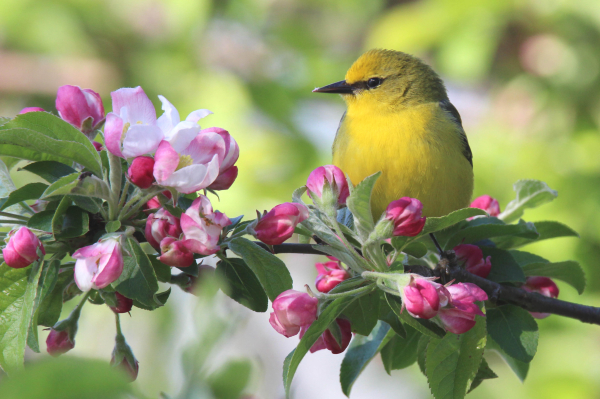
Four days of the best weather at the peak of spring in a swampy woodland bathed in the freshest air courtesy of a Lake Erie breeze – with the trees and bushes filled with new leaves, growing larger and greener each day; and a filtering of warblers, followed by waves of warblers! Last week I renewed my dedication to the Warbler Nation, although it’s not really a dedication, it’s much more of an acute attraction. But it goes deeper than that: Photographing 5-inch long warblers that move at the speed of lightning, a few inches at a time, rarely stopping – it’s hard, it's thrilling, it’s rewarding; it’s actually fantastic when you encounter a dozen different species of warblers, and then another dozen. A Magnolia here, a Blackburnian there, a Prothonotary next – it's a remarkable warbler parade; it’s remarkable – and it continues from morning until evening at Magee Marsh.
My best and favorite example of the 4+ days of warbler photography, and the thrills that went along with it, transpired during my last half-hour at Magee Marsh, a magical place during spring songbird migration. Before those last 30 minutes, I walked miles among a variety of warblers and took hundreds of photos of warblers. Highlights were the chance to compose many great photos of the only Blue-winged Warbler I’ve seen in more than a decade – only the second one I’ve seen in my life. I also took a couple documentary photos of a Life Bird – an extremely rare and formerly endangered Kirtland’s Warbler – the first I’ve ever seen. And there were lots of opportunities to photograph Black-throated Blue Warblers, Magnolia Warblers, Chestnut-sided Warblers, Prothonotarys, Yellow Warblers, and Bay-breasted Warblers.
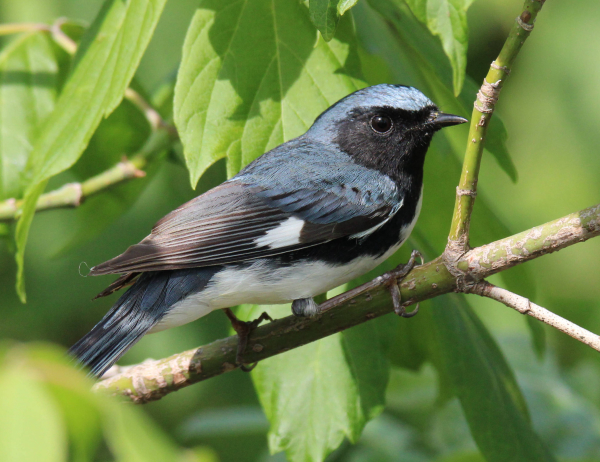
In the absence of photographable Northern Parulas and Cape May Warblers, entering my last day I hoped to get some ultimate photos of 3 species – Bay-breasted, Chestnut-sided, and Magnolia Warblers. I walked and photographed from 7am to 11 – the best hours of morning light, then resumed again about 3pm, but from 5pm to 7 was better light-wise and warbler-wise. As time was running out with the sun low in the sky, I reached the west entrance to the boardwalk without getting the ultimate photos I hope for – certainly some good ones, but not ultimates.
That’s when I spied an impressive male Bay-breasted Warbler foraging on a small distant tree. I moved into position as the Bay moved closer, then closer. I began photographing with the low sun at my back, and the spectacular warbler kept coming. Suddenly it was working the horizontal branch just a few feet before me. It was grabbing bugs here and there in the bark and under leaves, then jumping into the air to snag a flying insect again and again. How lucky was I, along with the dozen people sharing the same photo subject? It was a remarkable bird providing some remarkable photo time. I found myself short of breath from holding my breath as I photographed, and I was constantly zooming back and taking a couple steps backward cuz the bird was so close at times.

That’s about the time a second look-alike male Bay-breasted Warbler entered the scene, every bit as close and every bit as impressive. Depending on what the background looked like behind one or the other Bays, I took advantage of the choice of birds to photograph. And that’s about the time an adult male Chestnut-sided Warbler entered the scene, just as close and bathed in sunlight. All these warblers were active at eye level, sometimes a bit higher or a bit lower, intently foraging and providing super photo opportunities and refreshing surges of adrenaline and excitement. That’s when a second Chestnut-sided joined the photo fray! Four primo warblers before me as I tried to photograph the one in the best clear view position.
Moments later a glowing golden male Prothonotary Warbler flew in, and who wouldn’t turn their attention to it during its relatively short ground-oriented oh so close visit. Turning back to the Bay-breasted and Chestnut-sided Warblers, this was really a fun time to share this Warbler Nation event with about 20 other photographers and we all voiced words of exclamation and surprise with a level of disbelief as the birds continued to provide photo ops unlike any of us had witnessed that day or ever before.
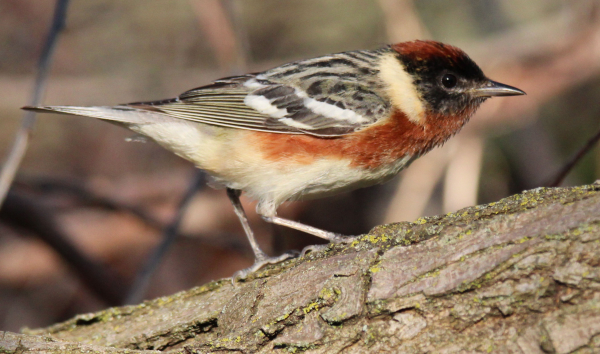
After about 20 minutes, a few people began to leave, drifting one way or the other with a sense of fulfillment. Eventually it was just me and one other photographer standing in awe at what just transpired before us. We talked in excited tones, thrilled with the action and not wanting to believe it was over. And that’s when we simultaneously saw a male Blackburnian Warbler with a fiery-colored breast glowing from afar – at about the same location where I spied the first Bay-breasted Warbler that started this whole warbler nation episode. I convincingly spouted that that impressive bird was on its way toward us, and sure enough, it worked its way in our direction, tree by tree, foraging ever-lower. We were laughing it was so surreal to have this warbler wave act in this fashion, providing us with opportunities to photograph at will.
As the fiery Blackburnian melted into the woods we stood quietly, wondering if that could be the end of our warbler run? We lingered a bit, waiting for the next one, looking at some photos through the LCD viewer on the back of our cameras. Then it hit me: How do I beat that day and that fantastic end to this warbler photo safari? Maybe never; probably never. That was quite a thrilling photo episode and it yielded my best Bay-breasted and Chestnut-sided Warbler photos. That was it; we recounted what a miraculous experience we had shared, together and with the others; we wished each other well, said “see ya next year,” and drove off into the sunset.
Helpful Photo Insights
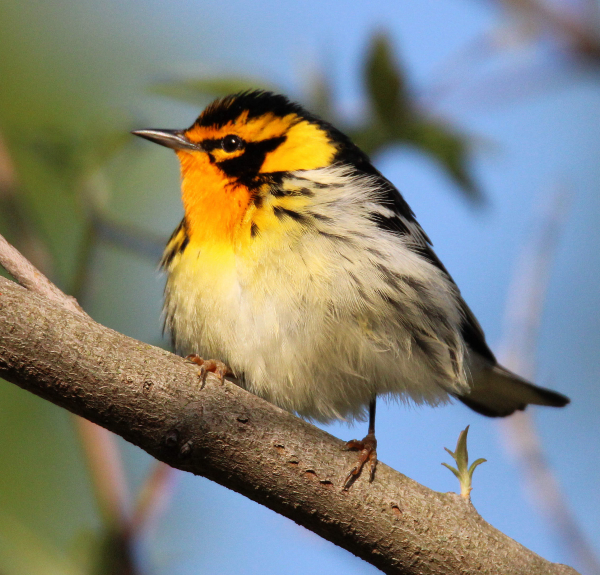
It’s no wonder why many birders count male Blackburnian Warblers among their favorites when you get a close view of the fiery color on its face and breast accented by bold black markings. Appreciate the sharp focus on all the warblers illustrated here, owing to the equipment and settings.
|
I share a couple more of the many memorable warbler photo episodes in my Editor Afield article in this issue, along with several other photographs, but here I’d like to share several insights into photographing warblers and other small songbirds. Some are standard to any bird photography that I’ve described before, but others are specific to photographing small songbirds including warblers, and a few are relative to photographing among other photographers and non-photographers.
First of all, a lot of planning went into this trip; I planned the days I would be on site at Magee Marsh according to the weather forecasts, starting a couple weeks ahead of my arrival. I hoped to arrive 6 days earlier, but there was limited sunlight and north winds that didn’t jive with the abundant sunlight and south winds I wished for. At last, it looked like there would be about 6 mostly sunny days starting Sunday May 8th, and the wind would switch to the south Monday evening, which would encourage songbirds to migrate north. I also needed to plan with my editorial duties in mind so I would get a regular weekly edition of The Birding Wire published early Wednesday morning.
So with the big picture timing set, it came down to taking advantage of sunny periods each day, primarily between 7am and 11, and again from 4pm to 7. That’s when the sun was shining from a 45- to 30-degree angle that would best illuminate birds with less chance of shadows forming on the underside of the birds, while providing the best natural colors of the warblers. [To determine the angle of the sun above the horizon, straight overhead is 90 degrees, the horizon is 0 degrees. Therefore, when the sun is positioned between these points – from 45 to 30 degrees, and maybe down to 20 degrees in some cases – that’s prime photo time in my book.]
Because there were so many songbirds in the area, I was able to be pretty selective about which birds, and even which species, I chose to try to photograph. I emphasized warblers, especially birds that I don’t encounter in Dakota; birds that were fairly close, foraging at or near eye level in good lighting. I avoided birds that were high in the trees, or in deep shade, or too far away. There were a few exceptions, but those terms worked well throughout my time afield.
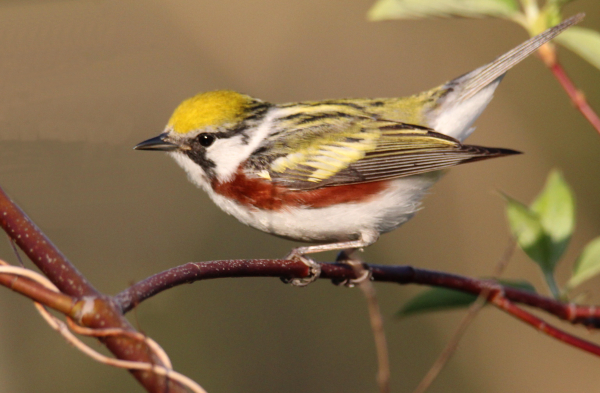
The other part of the selective process was to only react to birds on the sunny side of the boardwalk, when I had the sun behind me and the songbird in front of me. As always, I used my shadow as a pointer, knowing that when my shadow pointed directly at the bird I was in the best position for photography. It was a little surprising how often I rechecked my shadow, owing to the zigs and zags of the boardwalk as it meandered through the marsh.
Photography is all about the light, and for me, I am only confident in my bird photography when I have full sunlight at my back with an angle of 45- to 30-degrees above the horizon – because I’m disappointed with the results I get otherwise – so I’m passing that info on to you to use (or ignore) for greater successes in the field.
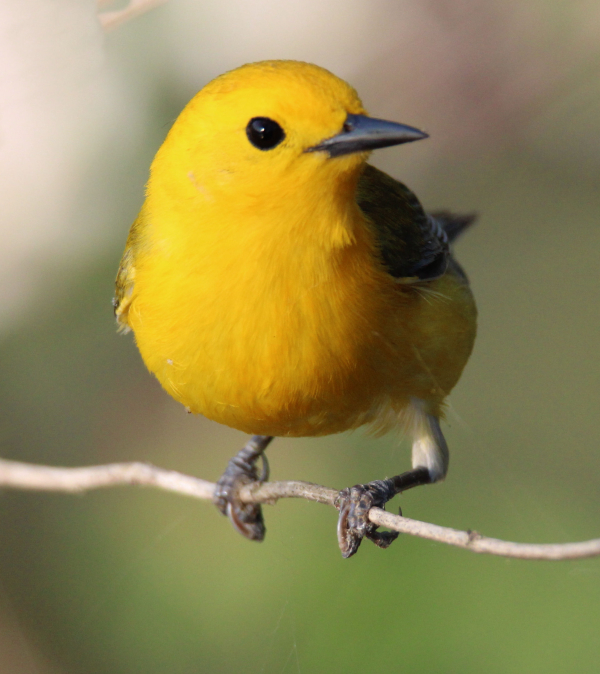
It’s surprising to see how the golden plumage of a Prothonotary Warbler literally glows in the sunlight. Larger than many other warblers, Prothonotarys seem to be more trusting too, often offering close views and photo ops.
|
When I found an interesting warbler, I liked to try to follow it as it made its way through the plants, often dense leaves and branches. In some cases, especially with male Black-throated Blue Warblers, I was able to follow their movements for a couple hundred yards, other times a couple hundred feet. And with all species I photographed I tried to follow them from branch to branch at least. In one case, there was a lone apple tree that was beginning to bloom that attracted a variety of birds, foremost of which was the Blue-winged Warbler. I was always drawn back to that blooming tree to spend a little time to see what birds would show up there and in the surrounding woods and marsh.
As I followed the ever-moving warblers and other songbirds as they foraged I watched for openings in the leaves and twigs and branches where they would emerge into a sunny opening for the best chances to take good photos. It took a lot of anticipation, fast reflexes, and a bunch ‘o luck, with many misses and a few successes each day. When I was photographing I held my breath while pressing the shutter button; and braced my elbows against my chest to help stabilize my camera and lens, or steadied my elbows or lens on the boardwalk railing.
I tended to use an f6 aperture, which reduced the area in focus, thereby creating a relatively blurred background and the fastest corresponding shutter speed, using the Av (aperture priority) option on the Mode Dial. I usually use a 400 ISO setting, but I opted to use 800 ISO due to the predominantly dark vegetation reading.
One thing that was especially helpful was to choose the center-focus option for the autofocus (AF) setting. That way I was most likely to have the focus on the bird I was actively following through my viewfinder.
As much as possible I tried to stay aware of shadows created underneath the birds or on one side or the other, as well as shadows on the birds that were created by plants and twigs around them. It’s tough, but it’s all part of the things to keep in mind as you are photographing. Similarly, I keep aware of the background behind the bird. It’s best if the background is unobstructed or uniformly colored, as with the sky or water; and the more space between the bird and the background, the better the likelihood that the background will be out of focus when using an f6 or f4 aperture.
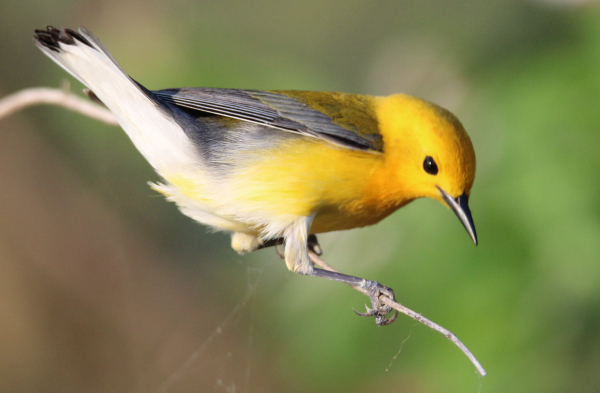
At Magee Marsh during the prime songbird migration period, the Warbler Nation is assembled by the hundreds most days, so people also become part of the warbler photography variables – mostly in good ways. Number one, the camaraderie between birders and especially bird photographers is great fun, and people are so friendly and helpful. Invariably, when an interesting bird is located, a few birders will stop, hoping to catch a glimpse or get some photos. People are very considerate not to get in the way of one another, and to provide space for others to get a look or a photo. Usually, you are on your own though, but it’s best to stay next to the boardwalk railing so people can pass behind you or get positioned beside you when photographing a bird.
I always try to move slowly and deliberately when I’m around birds I’m interested in photographing, trying to be of least concern to the birds. I also try to be friendly and smile as much as possible when other people are near – it enhances my experience and puts others at ease to enjoy their birding activities at their fullest. And that’s what birding is all about; enjoying the birds, enjoying people you encounter, sharing an interest in the natural world, and the birds that inhabit it. This trip to Magee Marsh was a most rewarding time that provided thoughts and emotions that will fuel me for many months to come, and I’ll remember how enjoyable it all was for years. Most of all, the assembled birds were unsurpassed within the Warbler Nation!
Article and photographs by Paul Konrad
Share your bird photos and birding experiences at editorstbw2@gmail.com